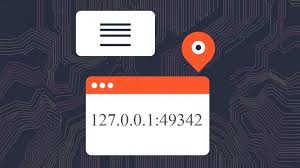Introduction to 127.0.0.1:49342
In the world of computer networks, IP addresses and ports are key components for establishing communication between devices. One commonly encountered term in this context is 127.0.0.1:49342. This combination refers to a local IP address and a port number. But what does it actually mean, and why is it important? In this article, we will break down 127.0.0.1:49342, explore its usage, and understand its significance in both local network configurations and specific applications.
Table of Contents
What is 127.0.0.1:49342?
To start, it is essential to understand what the components of 127.0.0.1:49342 mean.
- 127.0.0.1 is a special IP address known as the loopback address, used by a computer to refer to itself. It is commonly used in networking configurations for testing and diagnostics. It ensures that the network stack and software are functioning correctly without needing external network resources.
- 49342 is a port number that is used in combination with an IP address to create a unique socket for communication between applications. Port numbers allow multiple services to run simultaneously on the same IP address. The number 49342 is part of a range called dynamic or private ports, typically assigned to applications dynamically when a service needs to communicate locally.
When combined, 127.0.0.1:49342 refers to a local network endpoint for communication within the same machine or device. This can be crucial for various testing, development, or diagnostic purposes.

The Role of 127.0.0.1:49342 in Local Networking
Local Testing with 127.0.0.1:49342
One of the most common uses of 127.0.0.1:49342 is in the context of local testing. Developers use the loopback address (127.0.0.1) to simulate network connections without requiring external servers. This means that developers can run and test services on their own machine by using the IP address 127.0.0.1 and port numbers like 49342 to communicate between applications or services.
For example, a web server might be set to listen on 127.0.0.1:49342 for incoming requests, allowing the developer to interact with the server as if it were running on an external server but without needing to deploy it.
This local testing setup can be incredibly useful in development environments, allowing developers to debug their applications or services in isolation before exposing them to a broader network.

Security Implications of 127.0.0.1:49342
The use of 127.0.0.1:49342 also plays an important role in security. Since the loopback address refers to the local device, it prevents external sources from connecting to services or applications bound to this address. As a result, 127.0.0.1:49342 offers a form of isolation that ensures certain services are not exposed to external traffic unless specifically configured.
In some cases, applications running on 127.0.0.1:49342 might offer diagnostic information, error logs, or other sensitive data, and limiting access to this local address can be a critical security measure. The data intended only for internal consumption can be kept safe from malicious actors.
Practical Applications of 127.0.0.1:49342
Database Connections on 127.0.0.1:49342
In many scenarios, a local database might be accessed using the address 127.0.0.1:49342. For instance, databases such as MySQL, PostgreSQL, or MongoDB can be configured to listen on specific ports like 49342, allowing the database to accept connections from local clients or applications.
In a development setting, developers frequently configure database servers to only listen on 127.0.0.1 to prevent external access, ensuring that only their applications, running on the same machine, can communicate with the database. This is a security feature that also prevents unauthorized users from accessing sensitive data stored in the database.
Web Development and 127.0.0.1:49342
Web developers often rely on 127.0.0.1:49342 to test locally hosted websites or web applications. When working with frameworks like Node.js or Django, it is common to run a development server on the loopback address. For example, a development server might run at 127.0.0.1:49342, allowing developers to test the application in a simulated environment that closely mirrors the production environment.
Because this setup does not expose the website to the public, it is a safe space for testing changes to the code without impacting live users or services. Using 127.0.0.1:49342 as the address ensures that only local clients or applications running on the same machine can access the website, making it an ideal development tool.

Diagnosing Network Issues with 127.0.0.1:49342
Network diagnostics often involve using the loopback address to ensure the networking stack is functioning correctly. If a device cannot connect to 127.0.0.1:49342, it might indicate an issue with the system’s networking configuration or the relevant service running on that port.
Ping Test
A common network diagnostic tool is the ping command, which can be used to verify that a system can communicate with itself. By pinging 127.0.0.1, the system checks if the network stack is properly configured and if the device is capable of sending and receiving packets.
If 127.0.0.1:49342 is in use, pinging 127.0.0.1 can help verify the network functionality. Additionally, 127.0.0.1:49342 can be specifically tested by attempting to make a network connection to the port, ensuring that the appropriate service is running.
Tracing Network Connections
Another diagnostic tool often used in network troubleshooting is traceroute. By using this tool, network engineers can trace the path packets take from one system to another. When troubleshooting locally, 127.0.0.1:49342 can be used to confirm that the local machine is correctly handling requests sent to this address and port.
These network diagnostic tools help identify where issues arise within the network stack, whether due to software misconfigurations, blocked ports, or failed services.
The Importance of 127.0.0.1:49342 in Software Development
For software developers, understanding how to work with 127.0.0.1:49342 and other local networking concepts is crucial. Whether it’s testing APIs, debugging microservices, or running local servers, the loopback address is often involved in the development lifecycle.
Many modern applications are designed to work with specific port numbers for communication between microservices or components. In cases where services are built using containers or virtual machines, 127.0.0.1:49342 can be used as a communication endpoint between components running within the same host.
This makes 127.0.0.1:49342 an essential part of testing and managing services before deployment into a production environment. Developers can rely on this local communication to ensure that the application behaves correctly under controlled conditions.
Managing Services on 127.0.0.1:49342
Once developers have configured an application or service to run on 127.0.0.1:49342, they may need to manage or monitor its performance. This could involve:
- Checking if the port is open and listening.
- Ensuring that the application binds to the correct port (49342).
- Verifying that firewall or security settings allow local connections to 127.0.0.1:49342.
Various command-line tools, such as netstat or lsof, can be used to examine the open ports and services running on them. This can help diagnose issues such as port conflicts or unexpected shutdowns.
Port Conflicts and Solutions
One of the issues that may arise is a port conflict, where another service is already using 127.0.0.1:49342. In such cases, developers can resolve this conflict by either choosing a different port number or terminating the process that is using the port.
Port conflicts can be identified by using commands like netstat or checking through the system’s process manager to identify which applications are using specific ports.
Also Read: Drew Pritchard New Wife: Everything You Need to Know About His New Beginnings
Conclusion
In summary, 127.0.0.1:49342 plays an important role in local networking, software development, and network diagnostics. It represents the loopback address combined with a port number, which is commonly used for testing, debugging, and simulating network communication on the local machine.
Understanding the purpose and functionality of 127.0.0.1:49342 can help developers, system administrators, and network engineers maintain control over local communication services, ensuring both security and efficiency. Whether it’s for troubleshooting network issues, testing web applications, or managing databases, this local address and port combination remains a cornerstone of modern networking and software development.













